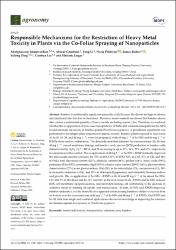| dc.contributor.author | Emamverdian, Abolghassem | |
| dc.contributor.author | Ghorbani, Abazar | |
| dc.contributor.author | Li, Yang | |
| dc.contributor.author | Pehlivan, Necla | |
| dc.contributor.author | Barker, James | |
| dc.contributor.author | Ding, Yulong | |
| dc.contributor.author | Liu, Guohua | |
| dc.contributor.author | Zargar, Meisam | |
| dc.date.accessioned | 2023-09-06T08:36:54Z | |
| dc.date.available | 2023-09-06T08:36:54Z | |
| dc.date.issued | 2023 | en_US |
| dc.identifier.citation | Emamverdian, A., Ghorbani, A., Li, Y., Pehl,van, N., Barker, J., Ding, Y., Liu, G. & zargar, M. (2023). Responsible Mechanisms for the Restriction of Heavy Metal Toxicity in Plants via the Co-Foliar Spraying of Nanoparticles. Agronomy Basel, 13(7), 1748. https://doi.org/10.3390/agronomy13071748 | en_US |
| dc.identifier.issn | 2073-4395 | |
| dc.identifier.uri | https://doi.org/10.3390/agronomy13071748 | |
| dc.identifier.uri | https://hdl.handle.net/11436/8272 | |
| dc.description.abstract | Bamboo is nutritionally significant across the world because the shoots are high in calories and nutritional fiber but low in cholesterol. However, recent research has shown that bamboo shoots also contain a substantial quantity of heavy metals, including arsenic (As). Therefore, we explored whether the co-application of iron oxide nanoparticles (IONPs) and selenium nanoparticles (Se-NPs) would attenuate As toxicity in bamboo plants (Pleioblastus pygmaeus). A greenhouse experiment was performed to investigate plant responses to arsenic toxicity. Bamboo plants exposed to four levels of As (0, 10, 20, and 40 mg L-1) were foliar-sprayed with 60 mg L-1 of Se-NPs and 60 mg L-1 of IONPs alone and in combination. The data indicated that different As concentrations (10, 20, and 40 mg L-1) caused membrane damage and reactive oxide species (ROS) production in bamboo cells, characterized by H2O2, O-2(& BULL;-), MDA, and EL increasing by up to 47%, 54%, 57%, and 65%, respectively, in comparison with a control. The co-application of 60 mg L-1 of Se-NPs + IONP markedly improved the antioxidant enzyme activities (by 75% in SOD, 27% in POD, 52% in CAT, 37% in GR, and 38% in PAL), total flavonoid content (42%), phenolic content (36%), proline (44%), nitric oxide (59%), putrescine (Put) (85%), spermidine (Spd) (53%), relative water content (RWC) (36%), photosynthetic characteristics (27%) in net photosynthesis (Pn) (24% in the intercellular CO2 concentration (Ci), 39% in stomatal conductance (Gs), and 31% in chlorophyll pigments), and ultimately biomass indices and growth. The co-application of Se-NPs + IONPs with 10 and 20 mg L-1 of As raised the TI by 14% and 9% in the shoot and by 18% and 14% in the root, respectively. IONPs and Se-NPs reduced ROS, cell membrane lipoperoxidation, and electrolyte leakage, all contributing to the decrease in oxidative stress by limiting As uptake and translocation. In sum, Se-NPs and IONPs improved bamboo endurance, yet the most effective approach for increasing bamboo's ability to recover from As toxicity was the concurrent use of 60 mg L-1 of Se-NPs and 60 mg L-1 of IONPs. Our IONP and Se-NP data from single and combined applications offer novel knowledge in improving the tolerance mechanism against As exposure in Pleioblastus pygmaeus. | en_US |
| dc.language.iso | eng | en_US |
| dc.publisher | MDPI | en_US |
| dc.rights | info:eu-repo/semantics/openAccess | en_US |
| dc.subject | Metal (oid) toxicity | en_US |
| dc.subject | Nanoparticles | en_US |
| dc.subject | Selenium | en_US |
| dc.subject | Iron | en_US |
| dc.subject | Bamboo | en_US |
| dc.title | Responsible mechanisms for the restriction of heavy metal toxicity in plants via the co-foliar spraying of nanoparticles | en_US |
| dc.type | article | en_US |
| dc.contributor.department | RTEÜ, Fen - Edebiyat Fakültesi, Biyoloji Bölümü | en_US |
| dc.contributor.institutionauthor | Pehlivan, Necla | |
| dc.identifier.doi | 10.3390/agronomy13071748 | en_US |
| dc.identifier.volume | 13 | en_US |
| dc.identifier.issue | 7 | en_US |
| dc.identifier.startpage | 1748 | en_US |
| dc.relation.journal | Agronomy Basel | en_US |
| dc.relation.publicationcategory | Makale - Uluslararası Hakemli Dergi - Kurum Öğretim Elemanı | en_US |


















